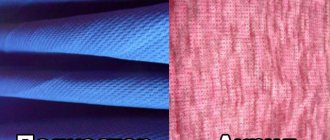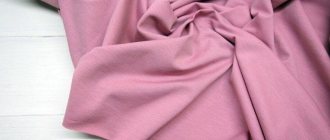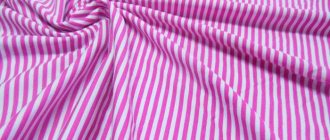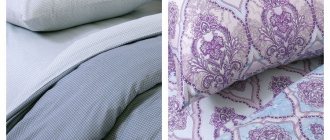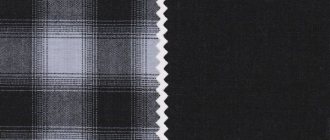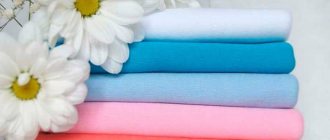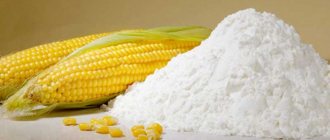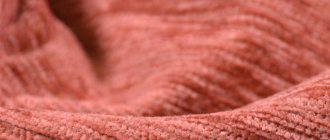Interlock: what kind of material is it and its features
Translated from English, interlock means “crossing.”
This material is 100% cotton but has a nice smooth finish on both sides. Its density is 240-330 g/m2. Interlock is classified as double knitwear, since two rows of knitting machine needles are used in the manufacture of the fabric. During the weaving process, the erasers intersect imperceptibly within the fabric, resulting in a double-sided fabric that has no face and no back. Hence the second name - dvulastic.
Since such knitwear is very soft and pleasant to the body, children's clothing, pajamas, dressing gowns and much more are made from it. If you change the knitting mode, you can get a fleecy material, and two colors of thread when knitting give a checkered or striped pattern. Often a printed design is applied to clothing.
Types of interlock
According to international markings, there are three types of interlock depending on the quality of grinding:
- Peña is a fabric that is produced using the best long threads. The material is perfectly smooth, thin, a little silky to the touch, but quite durable. It practically does not wrinkle, does not wrinkle, and retains its shape for a long time. Retains heat well. Provides free air circulation.
- Ring (carde) - made from medium-length cotton threads, as a result the fabric is slightly looser than foam. Good performance is noted. The matter is quite dense and warm.
- Open End - knitted from the shortest and loosest threads. The resulting knitwear has a lot of fibers - the tips of these same threads. In terms of cost, oppened is the most inexpensive in its class.
How does the cooler fabric behave after washing?
The fabric behaves well both during machine and hand washing. It can be washed even at fairly high temperatures, which is very important when processing children's clothing.
Cooler fabric after washing:
- If you evaluate the shrinkage of the cooler, it differs depending on the composition of the fabric. As mentioned above, cotton is often combined with elastane or polyester thread.
- If the fabric is made of 100% cotton, it will shrink during the first wash. Take this into account when purchasing children's things.
- Take a size larger, as the fabric may shrink after washing in hot water.
Printed
Basic properties of interlock
- Wear resistance. Withstands use well and is resistant to abrasion. The structure of the fabric and the quality of the threads ensure a good appearance without puffs, holes or pilling.
- Persistence. Even after being stretched, things can return to their original shape.
- Hygroscopicity. The material perfectly absorbs moisture and releases it.
- Breathability. Interlock provides good air exchange, which is especially important for an active lifestyle.
- Thermal insulation. These clothes are quite comfortable in the cold season.
Application
The main use of interlock material is sewing underwear for men, women and children. This is not surprising, since the smooth surface texture does not irritate even the delicate skin of babies.
From double elastic they sew:
- tracksuits;
- T-shirts;
- sweatshirts;
- skirts and dresses;
- rompers and vests;
- hats;
- pajamas;
- robes;
Less common are bedding and capes, as well as soft toys. The scope of application, although limited, is very diverse. Much depends on the imagination of the fashion designer who wants to realize the conceived image.
Rules for caring for interlock products
In order for clothes to maintain their appearance longer, they need to be properly cared for. Usually, the manufacturer leaves its care recommendations on a special label for each item. It is very important to familiarize yourself with this information so as not to spoil the material.
The basic rules for careful care of interlock products are:
- temperature regime – no higher than 40°C;
- hand wash or delicate machine wash;
- low spin speed;
- washing powder without chlorine bleaches;
- ironing the product from the wrong side;
- drying things in a dark, well-ventilated place;
- For storage, items must be neatly folded or hung on hangers.
Rules of care
In order for products made from stockinette to serve for a long time, you need to follow the rules of care. Before first use, the item must be washed. For washing, it is recommended to use delicate powders - liquid, special products with a gentle composition. Bleach or chlorine can damage things.
It is advisable to wash things by hand or in the “silk” mode. You should also follow these instructions:
Variety of colors
- the water temperature should not exceed 45 degrees;
- It is not advisable to squeeze it in a machine; you can use a towel for this. You need to take a terry towel and carefully squeeze out excess water;
- If stubborn stains have formed on the product, they are removed mainly with laundry soap. To do this, you first need to soak the item in a bowl of cold water and then wash it with soap. In extreme cases, you can use a stain remover for delicate materials;
- It is advisable to dry things from the cooler not vertically on clothespins, but horizontally, laying them out on the table surface. This is necessary so that the product does not stretch under the weight of water. When drying, the item must not be exposed to UV rays;
- There is no need to iron the products, as the fabric does not wrinkle. If ironing is necessary, it is advisable to do it at a temperature not exceeding 100 degrees or using a steamer.
You can store things either folded or on hangers in the closet. The likelihood of creasing is very low. But it is recommended to keep children's clothing separately, even if the composition is the same.
You might be interested in Features of crepe georgette: fabric properties
Footer with fleece
The difference between interlock and cooler
Kulirka, unlike interlock, is a very thin 100% cotton knitwear formed by a cross-knit single weave. Ideal for the production of underwear, children's caps and baby vests. Its density is 145-180 g/m2.
It has a smooth surface, on the front side in the form of a kind of “braids”, on the back side – “brickwork”. Since cooler and interlock differ significantly in density, their areas of application are slightly different.
The overwhelming majority of positive reviews about the quality of interlock products prevail. This is especially true for children's clothes: hypoallergenic, soft, and do not hinder movement.
It is easy to care for, allowing you to keep the item in good condition.
A small percentage of negative reviews are usually associated with improper washing and non-compliance with the manufacturer’s recommendations, or with the purchase of a low-quality product.
The main difference between cooler and interlock
The main distinguishing feature is the density of the fabric. The wear resistance of the finished product, as well as suitable areas of application, depend on its degree.
The leader in this criterion is interlock, which will warm you up perfectly. For hot weather, a cooler is preferable - thinner and lighter. Another significant advantage of interlock is that as a result of damage, “arrows” do not appear and the product will not unravel.
Judging by the ability to restore its original shape after stretching, then interlock will cope with this faster.
The addition of synthetics to the interlock composition is not allowed, and the cooler may have a small proportion of lycra (from five to ten percent).
The interlock has no back and front sides, unlike its opponent.
Important! Following the rules for caring for cotton knitwear will prevent shrinkage and stretching. Information on the permissible washing and ironing temperatures can be found on the label. It is also recommended to use washing gel rather than washing powder.
Description of how knitted fabric
The thinnest knitted fabric is considered to be a knit, which practically does not change in length, but stretches perfectly in width, while maintaining its shape. Outwardly, it resembles stocking stitch: on the front side there is a pattern in the form of flat thin braids located vertically. On the reverse surface there is an ornament in the form of rectangles.
Properties and characteristics
What kind of interlock fabric? The fabric is double-faced and contains 100% cotton. A minimal addition of viscose, elastane, lycra, or polyester is possible, as the manufacturer reports on the label. In the presence of synthetic fibers, the characteristics of interlock deteriorate.
The most important characteristics of interlock fabric:
- Hygroscopicity . The material absorbs well, allows moisture to pass through, and dries quickly after washing.
- Air permeability . The material is breathable, so you won't sweat in interlock clothes.
- Wear resistance . The fabric retains its original appearance for a long time; pills and creases do not appear on it.
- Extensibility . Interlock practically does not stretch, but when deformed it quickly acquires its original appearance.
- Hypoallergenic . In 100% cotton, the body does not sweat and there is no allergic reaction on the skin.
- Thermoregulation . The fabric maintains a suitable temperature regime, so the child does not freeze or sweat.
- Durability . Interlock density – from 180 g/m².
Considering these characteristics of the fabric, it is clear why interlock is often used to sew underwear for children, men, and women.
Advantages
When tightly knitted according to the weaving pattern of threads, the material has high wear resistance.
The list of interlock advantages does not end there:
- preservation of the original form;
- softness;
- no skin allergies;
- durability;
- naturalness;
- breathability;
- hygroscopicity;
- keeping warm;
- easy hand/machine wash;
- color fastness;
- no pellets.
Flaws
There are also negative aspects of this choice:
- shrinkage when washed in hot water;
- poor elasticity;
- inappropriate things for summer.
Let's sum it up
Why is it better to use a cooler?
Thanks to its remarkable properties, the kulirka is ideal for sewing items for newborns: vests, overalls, caps, rompers.
The baby's body breathes well and does not sweat. The stores offer a wide range of everyday items for adults and children: light dresses, airy sundresses, T-shirts, shorts, skirts, underwear, T-shirts. For a cozy home wardrobe: nightgowns and pajamas, dressing gowns, home sets. Fans of an active lifestyle prefer tracksuits due to their hygiene. These products are especially relevant in the summer due to their thinness and excellent breathability.
What is interlock best suited for?
Interlock is used to create clothes similar to those made from kulirka. Due to its excellent wear resistance and versatility, it is possible to sew bedding, bedspreads and curtains. And thanks to the increased thermal insulation, sweaters, trousers, jackets, dresses, skirts will keep you warm in cool weather.
Which knitted fabric is better, knitted fabric or interlock?
Natural materials are pleasant to the body, hygroscopic, and environmentally friendly. They are indispensable for underwear, children's clothing and much more. When choosing an item or cotton knitwear fabric via the Internet, housewives most often come across the names kulirka and interlock. Which one is better, how they differ and how to care for natural fabrics - read our article.
What is a cooler
Kulirka is the thinnest knitted fabric, which, without losing its shape, stretches perfectly in width and almost does not stretch in length. This is a type of cross-linked single-layer fabric. On the front surface the pattern looks like vertical braids. The reverse side of the cooler has the appearance of dense brickwork. That is, in appearance the material resembles ordinary stocking knitting.
The fabric can be made from 100% cotton, sometimes 5-10% lycra is added to the fabric to increase wear resistance, elasticity and ability to keep its shape.
There are three types of coolers based on color:
- the printed one has a pattern, it can be camouflage, flowers, vest, geometric patterns;
- plain dyed - a plain fabric that is distinguished by an extraordinary variety of colors;
- melange is a fabric made from threads of various shades that harmonize or contrast with each other.
All types of embossing, silk-screen printing, thermal printing fit perfectly on the cooler, and embroidery looks harmonious on thick fabric.
Advantages:
- made from environmentally friendly raw materials;
- has excellent breathability;
- perfectly absorbs moisture;
- durable;
- does not shrink after washing;
- does not require special care;
- almost does not wrinkle.
Kulirka is a universal fabric; it is ideal for sewing light and comfortable clothes designed to be worn in the warm season. Shorts, skirts, T-shirts, pajamas, nightgowns, dresses and sundresses are made from kulir stitch. Shirts and T-shirts are sewn for men. Hygiene and excellent breathability make coolers a suitable material for making sportswear.
Rules of care:
- When washing, the water temperature should not exceed 40˚ C.
- You cannot rub the fabric if a stain appears on it; it is better to use a stain remover.
- Clothes from the cooler should be dried inside out, away from heating devices.
- You can iron the products with a hot iron, but if the composition contains synthetic threads, then a gentle mode is necessary.
Advice! Clothes from the cooler will be soft if you use liquid detergents rather than powder when washing. When rinsing, add fabric softener.
Kulirka: types of fabrics
There are several types of coolers that can be found in the market.
Cooler, types of fabrics:
- With lycra. Very thin, knitted fabric, which is based on cotton. Due to the presence of lycra, it stretches quite well and returns to its previous position. Thanks to the presence of lycra, wear on the fabric is minimal, so the fabric behaves well when washed in hot water. Due to the presence of lycra, the fabric does not shrink.
With lycra - You can find a cooler with a low content elastane and polyester fibers. This is a cheaper type of kulirka, because part of the cotton is replaced by artificial threads. Good fabric, does not fade, does not shrink when washed. If assessed by touch, the fabric is coarser and stiffer than a cooler made of cotton.
With elastane - The most expensive is fabric with 100% cotton content. There are no additional impurities in the composition. Typically, shirts and T-shirts are made from this fabric. The fabric is completely matte and shrinks slightly during washing.
HB
What is interlock
This is a knitwear made from 100% cotton, without a back or front, equally dense and smooth on both sides. The fabric differs from other types of knitted fabrics by the interlacing of loops, which results in the formation of a reliable and durable structure of the material. Interlock has another name - dual elastic.
Interlock knitwear
Advantages:
- has excellent hygroscopicity, excellently absorbs and releases moisture;
- The fabric is easy to wash and iron;
- the fabric is hypoallergenic;
- keeps its shape perfectly;
- does not shrink after washing;
- does not lose its attractive appearance during wear;
- practically does not wrinkle;
- the material is resistant to abrasion and pilling;
- has increased wear resistance due to its density.
Despite the density and excellent heat-shielding qualities, interlock is characterized by good breathability. These properties make the material indispensable when sewing sportswear; it turns out to be very comfortable. Suits, pajamas, dressing gowns, turtlenecks, and clothes for children are made from interlock.
There are rules for caring for this fabric:
- Washing should be delicate, and the water temperature should not exceed 40˚ C.
- It is not recommended to dry interlock clothes in the sun; the best option for this is a shaded place.
- It is prohibited to use powders containing chlorine when washing.
- Clothes made from this fabric can be stored folded or hung on hangers.
Interlock
Description of how knitted fabric
Interlock, unlike stockinette, has a smooth fabric on both sides. It is obtained due to the dense interweaving of the loops with each other (in translation it means “crossing” or double-strap). Due to this, a reliable fabric structure is formed.
What is included in the composition, how is it produced?
In accordance with the requirements of the standards, the composition contains only components of natural origin.
Depending on the quality of the raw materials, the following varieties are distinguished:
- The highest quality canvas is foam (smooth surface, no roughness or knots).
- Good quality canvas - ring (more loose threads are used for production).
- Inexpensive fabric - open end (short fibers are used for production).
What properties does interlock have?
Made from completely natural raw materials, it has a whole list of positive qualities: high hygroscopicity, pleasant to the touch, hypoallergenic, maintaining an attractive appearance during long-term wear, durability, resistance to deformation and pilling, and does not shrink after washing.
What is the difference between interlock and cooler?
Both materials are knitted fabric, but there are still differences between them.
Main differences:
- Kulirka differs from interlock in its stretchability: it stretches greatly in width and practically does not change in length. In addition, the cooler takes on its previous shape more slowly.
- Interlock does not contain synthetic or artificial fibers; only natural raw materials are used in production. The composition of the cooler can include from 5 to 10% lycra.
- Interlock is stronger and has greater wear resistance compared to stockinette.
- Interlock does not have a back or front side; it is a double-sided material. The “face” and the back of the cooler are different.
- The difference also lies in the difference in density. Kulirka is much thinner and more delicate, so it is perfect for sewing summer clothes. With the same thickness, the quality of the cooler will be higher.
- If the interlock thread accidentally breaks, the fabric will not unravel.
Which of these two knitted fabrics you choose depends on what the product will subsequently be used for. For example, interlock is worse for sewing summer clothes due to its high density.
Cooler fabric: advantages
The cooler has a lot of advantages, including versatility. Typically, the fabric is used in the manufacture of children's and adult clothing. Depending on the type of kulirka, it is mainly used in the summer, but there is a thick fabric that is suitable for sewing winter underwear. The main advantage is breathability. This is an ideal option for children, because the skin will not sweat and the likelihood of heat rash will be minimized.
Cooler fabric, advantages:
- Doesn't wrinkle. Often such clothes do not wrinkle after washing in hot water. It does not need to be ironed, because after washing it does not contain creases.
- Eco-friendly fabric. It is absolutely safe for health. Another advantage is ease of use. There are no difficulties when washing and ironing this linen. You can use chemical cleaners and bleaches to remove stains.
- Absorbs moisture, so the likelihood of rashes and discomfort is minimal. The child, even in the summer heat, will not feel discomfort, and the seams will not chafe. The fabric is durable, it does not fade, even if regularly washed in hot water and dried in the sun.
With lycra
Kulirka – tender and light
Externally, the kulirka resembles ordinary stocking knitting on knitting needles: thin “braids” are barely visible on the front side, and the backside consists of small “cubes”. This is achieved by special cross-knitted weaving, when each row is sequentially formed using one curved thread. It is not for nothing that the word “kulirka” is translated from French as “kink”, “bend”.
Kulirka is one of the thinnest knitted fabrics, most often made from 100% natural raw materials - cotton, wool or silk. In order to increase wear resistance, elasticity and strength, synthetic elastane is sometimes added to the jersey. But according to all standards, its content should not exceed 5–10% of the total mass, so this does not affect the safety and environmental friendliness of the material.
Knitted fabrics can have different densities. Softer ones hold their shape worse, can stretch during prolonged wear, wrinkle and shrink after washing. Thick knitwear has sufficient tensile strength, does not wrinkle and retains its appearance after numerous washes. These types of kulirka are more often used for sewing outerwear.
Varieties of cool fabric
The softness, strength and other properties of hosiery fabric depend not only on the density of the weave, but also on the composition of the fibers. As a rule, three types of yarn are used for knitwear:
- Peña. Yarn with long (up to 0.8 m) fibers, which, before entering the knitting machines, undergo special grinding: all fibers are removed from them, and they become smooth and shiny. This most expensive type of cooler also has the highest quality indicators - it does not shrink, does not form pills, and does not wrinkle.
- Card. The fibers of this yarn are of medium length and are not pre-treated, due to which the fabric can be deformed during wear - stretched in width or length. Carded products do not have a long service life, but have an affordable cost.
- Open End. This very affordable yarn contains not only short-length fibers, but also waste obtained from the production of foam and carde. This knitwear is most often used for sewing simple everyday underwear that is not worn for too long.
If all of the above types of knitted fabric are made from pure cotton, then elastane fibers are introduced into the composition for stretch jersey. They give the material elasticity and increase elasticity.
It is important to know! Although elastane is a synthetic fiber, it does not cause skin irritation or allergic reactions. Therefore, even small children can buy stretch clothes without fear.
Knitted fabric lends itself well to dyeing, and cross-knitted weaving allows you to obtain quite interesting shades. Depending on the type of decoration, the materials are:
- Plain dyed - plain canvases of various colors.
- Melange - interweaving threads of different colors gives a unique play of colors.
- Printed - using embroidery, thermal printing or silk-screen printing, designs and prints are applied to the fabric.
Whatever color the knitwear is, it has a number of undeniable advantages:
- High breathability. The canvas provides air exchange and does not float the body.
- Hygroscopicity. The cooler easily absorbs moisture.
- Environmentally friendly. The material consists of at least 90% natural raw materials.
- Strength. The fabric can withstand significant tensile and tensile loads.
Interesting to know! It is noteworthy that the cooler does not form folds or creases, so clothes made from such knitwear can be stored folded on the shelves of the closet without fear that they will wrinkle.
Rules of care
With all the listed advantages, the cooler also has a drawback: if not properly cared for, it can shrink or stretch. Therefore, before putting clothes in the washing machine, you should read the recommendations on the label. Most often they read:
- Washing water should not be higher than 400C; it is better to choose the mode for delicate laundry.
- When washing by hand, do not rub the material too hard, even if there is a stain on it. It is better to use a special stain remover for knitwear.
- You need to dry clothes by turning them inside out, away from heating appliances.
- You can iron 100% cotton jersey with a hot iron. If synthetic fibers are present, set the gentle mode.
In order for clothes from the cooler to become soft after washing, it is advisable to use liquid detergents rather than powders, and add conditioner when rinsing.
What can you sew?
Kulirka is a universal knitwear that does not float in the summer heat and keeps you warm in the cold. Clothes made from it are light, comfortable, soft and pleasant to the body. What kind of products can be sewn from kulirka? The list looks quite impressive.
- Clothes for newborns - baby vests, rompers, caps, blouses, overalls.
- T-shirts, panties, shorts, T-shirts, shirts for older children.
- Skirts, dresses, tunics and sundresses for adults and children.
- Men's T-shirts, briefs, shorts and T-shirts.
- Clothes for home – nightgowns, pajamas, dressing gowns.
- Tracksuits.
Clothes made from knitwear are a godsend for parents of little toddlers. In it, the child will feel free and comfortable: run, crawl, jump, without fear of sweating. Beautiful and comfortable clothes from the cooler can be found in every store. Affordable prices and excellent quality make them one of the best-selling.
What do interlock and smoking rooms have in common?
Both materials are knitted fabric . They are distinguished by their affordable cost and ease of care, and are available in plain, multi-colored, patterned and patterned. The general properties of materials are not limited to this:
- Hypoallergenic . The fabrics are safe and do not cause an allergic reaction, so parents do not have to worry about the dangers of the products for both adults and children.
- Tactile sensations . The materials feel great on the body due to the fact that they allow air to pass through well. The canvases do not cause discomfort. They stretch and do not restrict movement.
- Durability . Both types of knitwear are characterized by increased strength properties and retain an attractive appearance after repeated washing.
- Hygroscopicity . The fabrics perfectly absorb moisture and do not cause irritation to the skin. They evaporate the liquid, pushing it out. This is especially important for sportswear and children's products.
The materials cannot be called analogues. There are significant differences between them.
Interlock - soft care
Unlike a cooler, where the front and back sides are clearly demarcated, interlock knitted fabric is double-sided. This is achieved through a special double weave in which the threads cross each other.
As a matter of fact, the word “interlock” means “crossing” in English. The second name of this canvas is dvulastic. The difference between interlock and many other knitted materials is that the double elastic does not form “arrows” when damaged.
Important! Real interlock consists only of natural cotton fibers, although recently some manufacturers have introduced a certain percentage of synthetic threads in order to reduce costs.
Just like kulirka, interlock has several varieties, differing from each other in the smoothness and length of the fibers:
- foam - an absolutely even and smooth canvas without the slightest knots or roughness;
- ring - medium quality fabric made from shorter and looser threads;
- open end - canvas of the lowest quality with multiple irregularities.
Interlock knitwear with fleece is also available. As a rule, low grade yarn is used to produce this material.
Advantages
Made from 100% cotton raw materials, interlock retains all the positive qualities inherent in natural materials:
- increased thermal insulation – interlock clothing will keep you warm even in the coldest weather;
- pleasant tactile sensations - the fabric is soft, with a slight silkiness;
- hygroscopicity - the material perfectly absorbs and releases moisture;
- durability – the strength of the weave provides interlock with increased wear resistance;
- hypoallergenic - the material does not cause irritation or redness upon contact with the skin;
- dimensional stability - knitwear does not wrinkle and quickly restores its shape.
The difference between interlock and cooler is that even low-quality dual-elastic does not change its original shape during long-term use.
Interesting to know! By interweaving fibers of several colors, knitwear manufacturers achieve the effect of striped or checkered fabrics. In addition, interlock dyeing uses a printing method in which each color is applied to the finished fabric on top of the other.
Product care
Knitted items love to be treated with care and precision. In this case, they will retain their original beauty and softness for a long time. The basic rules for caring for interlock products are as follows:
- You can wash clothes by hand or in a machine. In this case, the water temperature should not exceed 400C.
- It is best to spin at the lowest speeds.
- It is advisable to remove stains on knitwear before soaking and washing.
- Products should be dried avoiding direct sunlight.
- Interlock clothes do not need ironing.
It is not recommended to use powders containing chlorine for washing, as this can lead to discoloration of the fabric.
Interlock is a universal material
Interlock is a cozy, delicate, soft, quite durable material, so its scope is varied.
- Clothes for babies from the very first days of life.
- Children's and adult underwear.
- Home textiles – nightgowns, pajamas, dressing gowns.
- Clothes for fitness and sports.
- Children's and adult blouses, sweaters, skirts, turtlenecks, trousers, dresses.
Double elastic is a truly universal knitwear, since not only clothes are sewn from it, but also bed linen, bedspreads, tablecloths and even curtains.
A comparison of the two thinnest knitted materials, interlock and knitwear, shows that each of these fabrics can rightfully be considered the best for sewing clothes for both adults and children.
Which fabric should you prefer?
The knitwear is smooth on the front side, and on the back it resembles fine “brickwork”. Its thin fabric perfectly absorbs moisture, does not stretch, and holds its shape well. There are no folds or dents left on the fabric even with active movement. It is perfect for sewing:
- Sports suits.
- Home clothes.
- Men's underwear, T-shirts, shorts.
- Children's clothing - from birth to adolescence.
- Dresses, tunics, sundresses, skirts.
The material is a real find for parents. It requires minimal maintenance and is wear-resistant. However, when choosing clothes from the cooler, you should remember that they are more suitable for the summer season than for autumn and winter.
Soft, delicate, pleasant to the body, interlock is a material that can be used not only on the front side, but also on the back side. It resembles an elastic band that returns to its original shape after being stretched. The fabric, like kulirka, is used for sewing adult, children's, sports, and home clothing.
This does not mean that there is no difference in application between the two materials. It is recommended to choose Interlock as a winter option. It has a denser texture and warms well. It makes beautiful curtains, bed linen, bedspreads, and tablecloths. The cooler is much less suitable for such purposes. It is thin, so it wears out faster as a home textile.
What is the difference between interlock and cooler?
How to choose cotton fabric, especially when each option has all the advantages of natural fabric? What is the difference between interlock and kulirka - two materials made from 100% cotton - we will look into this article.
Interlock and cooler - what's the difference? Let's take a look at the description of these materials.
What kind of fabric is cooler? The composition of the fabric is 100% cotton, sometimes artificial fiber - elastane - is added to give strength. The stockinette stitch resembles regular stockinette stitch on knitting needles. On the front side you can see thin braids, and the back “consists” of small cubes. If you compare which fabric is thinner, this knitwear definitely wins. This material is, in principle, the thinnest of knitted fabrics. Even more properties and information about this material are here.
What is interlock fabric? It is (like the cooler) a material made of 100% cotton. There cannot be artificial fibers here - otherwise it is not interlock. The knitting method of this knitwear is completely different - the threads here cross each other, a special double weave is used, which makes the fabric denser. The result is a double-sided fabric of increased density, with a clearly demarcated back and front side. If we compare which is tighter, a knit or an interlock, then the latter will certainly win. In principle, the method of knitting is the main difference between a knit and an interlock. It is described in even more detail in the article “What kind of interlock fabric?”
The photo shows both materials.
The difference here is that the cooler may contain synthetic fibers.
The quality of the fiber is what makes the fabric warmer, denser and softer. Both matter comes in three varieties:
- Peña is a fabric made from selected raw materials with long fibers.
- Carde is a medium quality material. Medium length fibers used here
- Open End is an inexpensive fabric made using the shortest fibers.
